Madygen Formation
The Madygen Formation (Russian: Madygen Svita) is a Late Triassic (Carnian) geologic formation and Lagerstätte in the Batken and Osh Regions of western Kyrgyzstan, with minor outcrops in neighboring Tajikistan and Uzbekistan. The conglomerates, sandstones and mudstones of the 560 m (1,840 ft) thick formation were deposited in terrestrial lacustrine, alluvial, fluvial and deltaic environments.
| Madygen Formation Stratigraphic range: Carnian ~235–222 Ma | |
|---|---|
| Type | Geological formation |
| Overlies | Cambrian to Carboniferous rocks |
| Thickness | 560 m (1,840 ft) |
| Lithology | |
| Primary | Conglomerate, sandstone |
| Other | Mudstone |
| Location | |
| Coordinates | 40.1°N 70.2°E |
| Approximate paleocoordinates | 41.2°N 60.6°E |
| Region | Batken & Osh Regions |
| Country | |
| Extent | Fergana Valley & Range |
| Type section | |
| Named for | Madygen village |
| Named by | Evgeny A. Kochnev |
 Madygen Formation (Kyrgyzstan) | |
The formation, extending across the Fergana Valley and Fergana Range, is unique for Central Asia, as it represents one of the few known continental deposits and the Madygen Formation is renowned for the preservation of more than 20,000 fossil insects, making it one of the richest Triassic Lagerstätten in the world. Other vertebrate fossils as fish, amphibians, reptiles and synapsids have been recovered from the formation too, as well as minor fossil flora.
The lake sediments of the Lagerstätte provided fossil cartilaginous fishes and their egg capsules and unusual Triassic reptiles like Sharovipteryx and Longisquama.[1][2] The wide diversity of insect fossils was first discovered in the 1960s and first described by Russian paleontologist Aleksandr Sharov, with a notable example being Gigatitan.[3]
Description
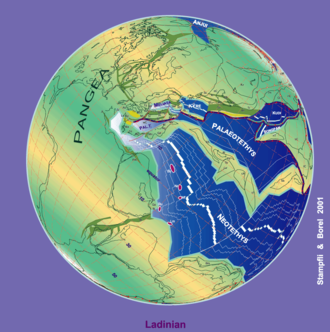
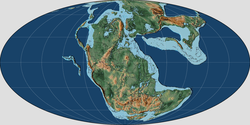
The Madygen Formation is a 560 metres (1,840 ft)[4] thick succession of predominantly siliciclastic rocks accumulated in a tectonically induced basin, covering parts of the Fergana Range and Fergana Valley of Kyrgyzstan with minor outcrops in Tajikistan and Uzbekistan.[5] The Late Triassic layers rest on top of Paleozoic basement with local Permo-Triassic molasse sediments. The section consists of mudstones, sandstones, conglomerates and fanglomerates. This wide variety of siliciclastic rocks reflects the complex spatial and temporal pattern of depositional sub-environments including alluvial fans, sandflats, swamps, back-swamp areas, and littoral to profundal lake zones. The fluvio-lacustrine deposits of the Madygen Formation belong to one of only a few occurrences of continental Triassic beds in Central Asia.[6]
The formation was deposited during the Carnian Pluvial Event (CPE), a global humid event leading to high extinction levels of various groups globally. The CPE led to anoxic conditions, most notably in the South China Block. The area where the Madygen Formation was deposited formed part of the Cimmerian microcontinent, a slab of crust that collided with Laurasia during the Cimmerian orogeny in later Mesozoic times. This orogeny led to the disappearance of the Paleo-Tethys Ocean.
Petroleum geology
The formation grades from bottom to top from alluvial to fluvial into a thick succession of lacustrine mudstones, followed by an alluvial package, on top of which lacustrine, fluvial, deltaic and alluvial layers were deposited.[5]
The hydrocarbon potential of samples of the Madygen Formation ranges from poor to excellent. The sediments containing more than 0.5% Total Organic Carbon (TOC) may be regarded as sources of gaseous hydrocarbons rather than of oil.[7] The Hydrogen Index (HI) of outcrop samples reaches 100 and the maximum recorded maturity (Ro) is 0.8.[8]
Paleontological significance
During the 1960s, Russian paleontologists recovered an unusually rich fossil content in the type strata of the Madygen Formation, including abundant macrophytes, more than 20,000 insect remains[9] and unique small reptiles with well preserved soft tissue.[6] Spirorbis-like polychaete worm tubes, crustaceans (ostracods, kazacharthrans, malacostraca), freshwater pelecypods and gastropods are known from shallow to deeper lake environments. Non-aquatic insects are among the most common fossil remains of the Madygen Formation. These include representatives of the orders Ephemeroptera, Odonata, Notoptera, Blattodea, Titanoptera, Ensifera, Caelifera, Rhynchota, Auchenorrhyncha, Stenorrhyncha, Coleoptera, Hymenoptera, Trichoptera and Diptera. Traces of insect larvae are preserved in near-shore lake deposits.[10]
Fish remains mostly represent endemic genera assigned to the actinopterygian families Evenkiidae (Oshia), Palaeoniscidae (Ferganiscus, Sixtelia) and Megaperleidus and Alvinia. The actinopterygian Saurichthys and the dipnoan Asiatoceratodus are cosmopolitan taxa also recorded in the Madygen Formation. Two distinctive elasmobranch egg capsule types, i.e. Palaeoxyris, indicating a small Lissodus- or Lonchidion-like hybodont shark and an indeterminate capsule type, imply the presence of two different elasmobranch species which used the freshwater environments of the Madygen Formation as spawning grounds. Tetrapods are known from a probably larval urodelan (Triassurus), a small procynosuchid cynodont (Madysaurus), a gliding reptile (Sharovipteryx) and the enigmatic diapsid Longisquama.[10]
Fossil content
Amphibians
| Genus | Species | Material | Notes | Images |
|---|---|---|---|---|
| Madygenerpeton | M. pustulatus | A chroniosuchid reptiliomorph[11] |  | |
| Triassurus | T. sixtelae | A possible early caudate (salamander) known from fossil larvae[12] | ||
Reptiles
| Genus | Species | Material | Notes | Images |
|---|---|---|---|---|
| Kyrgyzsaurus | K. bukhanchenkoi | A single specimen preserving the front half of a skeleton and scale impressions | A drepanosaur[13] | |
| Longisquama | L. insignis | A reptile with an elongated row of scales along its back[14] | 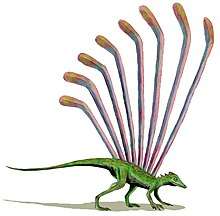 | |
| Sharovipteryx | S. mirabilis | A gliding prolacertiform[15] | 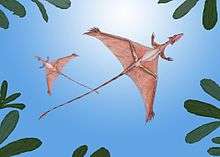 | |
Synapsids
| Genus | Species | Material | Notes | Images |
|---|---|---|---|---|
| Madysaurus | M. sharovi | A cynodont[16] | ||
Cartilaginous fishes
| Genus | Species | Material | Notes | Images |
|---|---|---|---|---|
| Fayolia | F. sharovi | An egg capsule likely belonging to a xenacanthid[1] | ||
| Lonchidion | L. ferganensis | Teeth and egg capsules | A hybodontid shark[1] | |
| Palaeoxyris | P. alterna | Teeth and egg capsules | A hybodontid shark[1] | |
Fishes
The following fish fossils were found in the formation:[10][17][18]
| Genus | Species | Images |
|---|---|---|
| Alvinia | Alvinia serrata | |
| Ferganiscus | Ferganiscus osteolepis | |
| Megaperleidus | Megaperleidus lissolepis | |
| Oshia | Oshia ferganica | |
| Saurichthys | Saurichthys orientalis | |
| Sixtelia | Sixtelia asiatica | |
Arthropods
| Genus | Species | Description | Notes | Images |
|---|---|---|---|---|
| Gigatitan | G. extensus | A mantis-like predator with a wingspan of approximately 33 centimetres (13 in). It is the type genus of the family Gigatitanidae. | [19] | 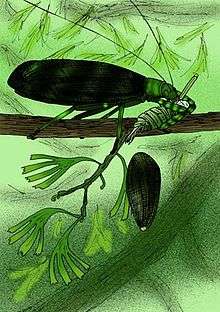 |
| G. magnificus | ||||
| G. ovatus | ||||
| G. similis | ||||
| G. vulgaris | ||||
| Aiban | A. kichineis | A member of Cnemidolestida/Cnemidolestodea (an extinct group of insects of uncertain phylogenetic placement, might be related to plecopterans or orthopterans) belonging to the family Sylvabestiidae | [20] | |
| Batkentak | B. intactus | A member of Grylloblattida/Eoblattida belonging to the family Daldubidae | [21] | |
| Chubakka | C. madygensis | A madygelline xyelid sawfly | [22] | |
| Locustoblattina | L. marginata | A member of Eoblattida belonging to the family Mesorthopteridae | [23] | |
| L. segmentata | ||||
| Madygella | M. aristovi | A madygelline xyelid sawfly | [22] | |
| M. bashkuevi | ||||
| M. kurochkini | ||||
| M. levivenosa | ||||
| Nestorembia | N. novojilovi | A webspinner belonging to the family Alexarasniidae | [24] | |
| N. shcherbakovi | [23] | |||
| Paratitan | P. reliquia | A right wing belonging to Neopterygota | [25] | |
| Sharovites | S. alexanderi | A member of Grylloblattida/Eoblattida, belonging to the family Mesorthopteridae | [26] | |
| Shurabia | S. tanga | A member of Polyneoptera belonging to the group Reculida and the family Geinitziidae | [27] | |
| Guillermia | G. lecticula | [28] | ||
| Madygenorhynchus | M. multifidus | |||
| Thaumatomerope | T. sogdiana | |||
| Prochoristella | P. longa | |||
| Dilemmala | D. specula | |||
| Sacvoyagea | S. ventrosa | |||
| Nonescyta | N. mala | |||
| Maguviopsis | M. kotchnevi | |||
| Falcarta | F. bella | |||
| Krendelia | K. ansata | |||
| Cuanoma | C. protracta | |||
| Phyllotexta | P. latens | |||
| Sitechka | S. perforata | |||
| Tingiopsis | T. reticulata | |||
| Pelorisca | P. connectens | |||
| Xamenophlebia | X. ornata | |||
| Thuringoblatta | T. sogdianensis | |||
| Sacvoyagea | S. ventrosa | |||
| Protoblattogryllus | P. variabilis | [29] | ||
| Megablattogryllus | M. austerus | |||
| M. pinguis | ||||
| Metakhosara | M. sharovi | |||
| Batkentak | B. intactus | |||
| Austroidelia | A. asiatica | |||
| A. nervosa | ||||
| Mesoidelia | M. faceta | |||
| Parastenaropodites | P. fluxa | |||
| P. longiuscula | ||||
| Baharellus | B. madygensis | |||
| Anoblattogryllus | A. fundatus | |||
| Costatoviblatta | C. aenigmatosa | |||
| C. conjuncta | ||||
| Paratitan | P. reductus | |||
| Prototitan | P. sharovi | |||
| Mesoedischia | M. obliqua | |||
| Paragryllavus | P. curvatus | |||
| Zagryllavus | Z. elongatus | |||
| Hagloedischia | H. primitiva | |||
| Voliopus | V. ancestralis | |||
| Euvoliopus | E. giganteus | |||
| Macrovoliopus | M. declivis | |||
| Paravoliopus | P. dorsalis | |||
| Voliopellus | V. latus | |||
| Triassaga | T. angusta | |||
| Zamaraga | Z. reticulata | |||
| Haglomorpha | H. martynovi | |||
| Modihagla | M. ovalis | |||
| Dulcihagla | D. mistshenkoi | |||
| Lyrohagla | L. uvarovi | |||
| Sonohagla | S. curta | |||
| Tinnihagla | T. zeuneri | |||
| Dolichohagla | D. longa | |||
| Locustavus | L. problematicus | |||
| L. intermedius | ||||
| L. minutus | ||||
| Miolocustavus | M. reductus | |||
| Brevilocustavus | B. distinctus | |||
| Fritaniopsis | F. brevicaulis | |||
| Sogdoblatta | S. nana | |||
| S. porrecta | ||||
| Thuringoblatta | T. sogdianensis | |||
| Xiphopterum | X. sharovi | |||
| Sharovoplana | S. parallelica | |||
| Triassophasma | T. intermedium | |||
| T. pusillum | ||||
| Prochresmoda | P. parva | |||
| Nestorembia | N. novojilovi | |||
| Madygenophlebia | M. bella | |||
| M. nana | ||||
| Gorochovia | G. individua | |||
| G. minuta | ||||
| G. bifurca | ||||
| Gorochoviella | G. conjuncta | |||
| Pseudoliomopterites | P. obscurus | |||
| Ideliopsina | I. nana | |||
| I. stupenda | ||||
| I. ornata | ||||
| Pseudoshurabia | P. pallidula | |||
| Peltosyne | P. varyvrosa | |||
| Ofthalmopeltos | O. synkritos | |||
| Obrienia | O. illaetabilis | |||
| Triassochorista | T. kirgizica | |||
| Parachorista | P. arguta | |||
| P. immota | ||||
| Choristopanorpa | C. temperata | |||
| Thaumatomerope | T. oligoneura | |||
| T. sogdiana | ||||
| Mesageta | M. rieki | |||
| Liassochorista | L. utilis | |||
| Agetopanorpa | A. deceptoria | |||
| Prochoristella | P. longa | |||
| Mesopsyche | M. ordinata | |||
| M. justa | ||||
| M. tortiva | ||||
| Psychotipa | P. predicta | |||
| Vymrhyphus | V. tuomikoskii | |||
| Gnomusca | G. molecula | |||
| Asiocula | A. lima | |||
| Fasolinka | F. beckermigdisovae | |||
| Fulgobole | F. evansi | |||
| Scytachile | S. emeljanovi | |||
| Serpentivena | S. tigrina | |||
| Coccavus | C. supercubitus | |||
| Kennedya | K. carpenteri | |||
| K. gracilis | ||||
| Batkenia | B. pusilla | |||
| Paurophlebia | P. lepida | |||
| P. angusta | ||||
| Neritophlebia | N. elegans | |||
| N. vicina | ||||
| N. longa | ||||
| Mixophlebia | M. mixta | |||
| Cyrtophlebia | C. sinuosa | |||
| Zygophlebia | Z. ramosa | |||
| Reisia | R. sogdiana | |||
| Shurabia | S. serrata | |||
| Mesoblattogryllus | M. intermedius | [19] | ||
| Protoblattogryllus | P. asiaticus | |||
| P. variabilis | ||||
| Megablattogryllus | M. austerus | |||
| M. magister | ||||
| Megakhosarodes | M. paulivenosus | |||
| Metakhosara | M. sharovi | |||
| Austroidelia | A. asiatica | |||
| A. nervosa | ||||
| Mesoidelia | M. ignorata | |||
| M. faceta | ||||
| Parastenaropodites | P. longiuscula | |||
| P. fluxa | ||||
| Locustoblattina | L. segmentata | |||
| Dorniella | D. primitiva | |||
| Baharellus | B. madygensis | |||
| Baharellinus | B. dimidiatus | |||
| B. pectinatus | ||||
| Costatoviblatta | C. aenigmatosa | |||
| C. similis | ||||
| Ferganamadygenia | F. plicata | |||
| Paratitan | P. libelluloides | |||
| P. venosus | ||||
| P. intermedius | ||||
| P. latispeculum | ||||
| P. modestus | ||||
| Mesotitanodes | M. tillyardi | |||
| M. similis | ||||
| Mesotitan | M. primitivus | |||
| Provitimia | P. pectinata | |||
| Proshiella | P. ramivenosa | |||
| Mesoedischia | M. madygenica | |||
| Gryllacrimima | G. perfecta | |||
| Madygenia | M. orientalis | |||
| M. ovalis | ||||
| Kashgarlimahmutia | K. reducta | |||
| Proxenopterum | P. primitivum | |||
| Axenopterum | A. venosum | |||
| Ferganopterus | F. clarus | |||
| Ferganopterodes | F. reductus | |||
| Pteroferganodes | P. rieki | |||
| Tuphella | T. rohdendorfi | |||
| T. sharovi | ||||
| Platyvoliopus | P. maximus | |||
| Stenovoliopus | S. elongatus | |||
| Zavoliopus | Z. densus | |||
| Turkestania | T. deviata | |||
| Triassaga | T. tshorkuphlebioides | |||
| Eumaraga | E. madygenica | |||
| Hagloptera | H. intermedia | |||
| Archihagla | A. tenuis | |||
| Proisfaroptera | P. martynovi | |||
| Protshorkuphlebia | P. triassica | |||
| P. similis | ||||
| Dulcihagla | D. beybienkoi | |||
| Lyrohagla | L. pravdini | |||
| L. decipiens | ||||
| Sonohagla | S. saussurei | |||
| S. chopardi | ||||
| Microhagla | M. minuta | |||
| Dinohagla | D. corrugata | |||
| Adzhajloutshella | A. plana | |||
| Locustavus | L. lanceolatus | |||
| L. problematicus | ||||
| L. intermedius | ||||
| L. deformatus | ||||
| L. minutus | ||||
| Dicronemoura | D. acaulis | |||
| Tritaniella | T. mera | |||
| T. synneura | ||||
| Fritaniopsis | F. brevicaulis | |||
| F. remota | ||||
| Sogdoblatta | S. nana | |||
| Thuringoblatta | T. sogdianensis | |||
| Subioblatta | S. madygenica | |||
| Xiphopterum | X. curvatum | |||
| Sharovoplana | S. affinis | |||
| Triassophasma | T. brevipoda | |||
| T. intermedium | ||||
| T. minutissimum | ||||
| Prochresmoda | P. minuta | |||
| Madygenophlebia | M. bella | |||
| M. primitiva | ||||
| Micromadygenophlebia | M. obscura | |||
| Gorochovia | G. individua | |||
| Ideliopsina | I. nana | |||
| I. ornata | ||||
| Madygenidelia | M. conjuncta | |||
| Pseudoshurabia | P. pallidula | |||
| Hadeocoleus | H. gigas | |||
| H. pelopius | ||||
| H. catachtonius | ||||
| Triassocoleus | T. tortulosus | |||
| Salebroferus | S. confragosus | |||
| S. asper | ||||
| Schizophoroides | S. rugosus | |||
| Thnesidius | T. xyphophorus | |||
| Catabrycus | C. hoplites | |||
| Triaplus | T. laticoxa | |||
| Dolichosyne | D. rostrata | |||
| Ademosyne | A. kirghizica | |||
| Cephalosyne | C. capitata | |||
| Cupesia | C. sepulta | |||
| Notocupes | N. laticella | |||
| N. rostratus | ||||
| N. tenuis | ||||
| Cladochorista | C. multivenosa | |||
| Prophilopotamus | P. asiaticus | |||
| Triassochorista | T. kirgizica | |||
| Parachorista | P. asiatica | |||
| P. multivena | ||||
| P. arguta | ||||
| P. sana | ||||
| Mesageta | M. pertrita | |||
| M. ignava | ||||
| Agetopanorpa | A. consueta | |||
| Prochoristella | P. longa | |||
| Mesopsyche | M. shcherbakovi | |||
| M. justa | ||||
| M. gentica | ||||
| Psychotipa | P. depicta | |||
| Nadiptera | N. pulchella | |||
| Oryctoxyela | O. anomala | |||
| Madygenius | M. primitivus | |||
| Ferganoxyela | F. sogdiana | |||
| F. destructa | ||||
| Triassoxyela | T. orycta | |||
| Nevicia | N. imitans | |||
| Asiocula | A. lima | |||
| Phyllotexta | P. latens | |||
| Fulgobole | F. evansi | |||
| Scytachile | S. cf. emeljanovi | |||
| Tingiopsis | T. reticulata | |||
| Coccavus | C. supercubitus | |||
| Permonka | P. unica | |||
| P. triassica | ||||
| Permosialis | P. triassica | |||
| Triassolestodes | T. asiaticus | |||
| Terskeja | T. pumilio | |||
| T. tenuis | ||||
| Paurophlebia | P. lepida | |||
| Cladophlebia | C. parvula | |||
| C. brevis | ||||
| Nonymophlebia | N. venosa | |||
| Neritophlebia | N. longa | |||
| Triadophlebia | T. madygenica | |||
| T. minuta | ||||
| T. magna | ||||
| T. honesta | ||||
| T. modica | ||||
| Mitophlebia | M. enormis | |||
| Xamenophlebia | X. ornata | |||
| Zygophlebiella | Z. curta | |||
| Mixophlebia | M. mixta | |||
| Shurabia | S. minuta | |||
| S. ferganensis | ||||
| S. anomala | ||||
| Maguviopsis | M. kotchnevi | [30] | ||
| Tingiopsis | T. reticulata | |||
| Dolichosyne | D. confragosa | [31] | ||
| Rhabdocupes | R. baculatus | |||
| Salebroferus | S. confragosus | |||
| Asiocula | A. lima | [32] | ||
| Blattomerope | B. polyneura | |||
| Cuanoma | C. protracta | |||
| Fasolinka | F. beckermigdisovae | |||
| Kirgizichorista | K. larvata | |||
| Krendelia | K. ansata | |||
| Lithocupes | L. incertus | |||
| Maguviopsis | M. kotchnevi | |||
| Megakhosarodes | M. paulivenosus | |||
| Nonescyta | N. mala | |||
| Obrienia | O. ingurgata | |||
| O. kuscheli | ||||
| Panorpaenigma | P. aemulum | |||
| Parachorista | P. religiosa | |||
| Phyllotexta | P. latens | |||
| Sacvoyagea | S. ventrosa | |||
| Siberioperla | S. ovalis | |||
| Sitechka | S. perforata | |||
| Sogdodromeus | S. altus | |||
| Triaplus | T. macroplatus | |||
| Megakhosarodes | M. paulivenosus | [33] | ||
| Choristopanorpa | C. opinata | [34] | ||
| Dzhajloutshella | D. arcanum | |||
| Kuperwoodia | K. benefica | |||
| Macrocatinius | M. brachycephalus | |||
| Neotuphella | N. minor | |||
| Pesus | P. prognathus | |||
| Mesageta | M. gigantea | [35] | ||
| M. rieki | [34] | |||
| Triassoxya | T. novozhilovi | [36] | ||
Flora
| Genus | Species | Description | Notes | Images |
|---|---|---|---|---|
| Mesenteriophyllum | M. kotschnevii | [14] | ||
Color key
|
Notes Uncertain or tentative taxa are in small text; |
Insect fauna correlations
Progonocimicidae found in the formation are also recorded in the Carnian Los Rastros Formation of Argentina, the Norian Blackstone and Mount Crosby Formations of Australia, and the Norian to Rhaetian Tologoi Formation of Kazakhstan.[37] Permochoristidae are also known from the Carnian Potrerillos and Cacheuta Formations of Argentina, Huangshanjie Formation of China, the Norian Blackstone and Mount Crosby Formations of Australia; the Norian to Rhaetian Tologoi Formation of Kazakhstan, the Sinemurian Dzhil Formation of Kyrgyzstan and the Toarcian Posidonia Shale of Germany.[38]
Orthophlebia had a relatively broad distribution in the Late Triassic as it is also found in the Sinemurian Badaowan Formation of China and Dzhil Formation of Kyrgyzstan, the Pliensbachian Makarova Formation of Russia and Sulyukta Formation of Tajikistan; the Toarcian Whitby Mudstone Formation of England, Posidonia Shale of Germany, and Cheremkhovo Formation of Russia, and the Early Jurassic Kushmurun Formation of Kazakhstan.[39]
Haglidae were also recorded in the Koldzat and Tologoi Formations of Kazakhstan, in the Carnian Cacheutá Formation of Argentina, the Carnian to Norian Molteno Formation of South Africa and Lesotho, and the Norian Mount Crosby Formation of Australia.[40]
See also
- Carnian formations
- Denmark Hill Insect Bed, insect-bearing unit of Queensland, Australia
- Candelária Formation, lacustrine formation of the Paraná Basin, Brazil
- Ischigualasto Formation, alluvial and fluvial Lagerstätte of Argentina
- Los Rastros Formation, insect-bearing formation underlying the Ischigualasto Formation
- Chinle Formation, fluvio-lacustrine fossiliferous formation of the western United States
- Doswell Formation, continental fossiliferous formation of the eastern United States
- Lossiemouth Sandstone, fossiliferous formation of Scotland
- Other Central Asian Lagerstätten
- Bissekty Formation, Turonian formation of Uzbekistan
- Bostobe Formation, Santonian to Campanian formation of Kazakhstan
- Karabastau Formation, Late Jurassic formation of Kazakhstan
- Danata Formation, Paleogene formation of Turkmenistan
References
- Fischer et al., 2011
- Unwin et al., 2003, pp.177-186
- Shcherbakov, 2008
- Fischer et al., 2018, p.25
- Berner et al., 2009, p.2
- Fischer et al., 2007, p.42
- Berner et al., 2009, p.5
- Berner et al., 2009, p.6
- Kelly, 2018, p.62
- Voigt et al., 2007, p.162
- Schoch et al., 2010
- Schoch et al., 2020
- Alifanov & Kurochkin, 2011
- Buchwitz & Voigt, 2012
- Sharov, 1971
- Tatarinov, 2005
- Kogan et al., 2009, p.142
- Franeck et al., 2013, p.54
- Sharov, 1968
- Aristov, 2018
- Aristov, 2015
- Kopylov, 2014
- Aristov, 2017
- Shcherbakov, 2015
- Béthoux et al., 2010, p.9
- Aristov & Storozhenko, 2013
- Aristov & Sukatcheva, 2018
- Shcherbakov, 2011
- Aristov et al., 2009
- Becker-Migdisova, 1953
- Ponomarenko, 1969
- Arnoldi et al., 1977
- Storozhenko, 1993
- Shcherbakov et al., 1995
- Novokshonov, 1997
- Gorochov, 2005
- Kelly, 2018, p.190
- Kelly, 2018, p.186
- Kelly, 2018, p.185
- Kelly, 2018, p.182
Bibliography
- Schoch, Rainer R.; Ralf Werneburg, and Sebastian Voigt. 2020. A Triassic stem-salamander from Kyrgyzstan and the origin of salamanders. PNAS 117. 11584–11588. Accessed 2020-05-27.
- Aristov, D.S., and I.D. Sukatcheva. 2018. New insects (Insecta: Trichoptera, Reculida, Eoblattida) from the Mesozoic of Asia. Paleontological Journal 52. 405–413. Accessed 2020-05-27. doi:10.1134/S0031030118040032
- Aristov, D.S. 2018. New and little known cnemidolestid insects (Insecta: Cnemidolestida) from the Middle Permian–Middle Triassic of Eurasia. Paleontological Journal 52. 1381–1390. doi:10.1134/S0031030118120079
- Fischer, Jan; Ilja Kogan; Sebastian Voigt; Michael Buchwitz; Jörg W. Schneider; Philippe Moisan; Frederik Spindler; Andreas Brosig, and Marvin Preusse, Frank Scholze & Ulf Linnemann. 2018. The mid-Triassic Madygen Lagerstätte (Southwest Kyrgyzstan, Central Asia), 25–26. 13th Symposium on Mesozoic Terrestrial Ecosystems and Biota. Accessed 2020-05-27.
- Kelly, Richard S. 2018. Effects of environmental perturbation during the Late Triassic on the taxic diversity of British insects, 1–337. University of Bristol.
- Aristov, D.S. 2017. New insects (Insecta: Eoblattida, Embiida) from the Permian of Russia and the Triassic of Kyrgyzstan, with observations on the origin of webspinners. Paleontological Journal 51. 161–170. Accessed 2020-05-27. doi:10.1134/S0031030117020046
- Aristov, D.S. 2015. Classification of the order Eoblattida (Insecta: Blattidea) with description of new taxa. Far Eastern Entomologist 301. 1–56. Accessed 2020-05-27.
- Shcherbakov, Dmitry E. 2015. Permian and Triassic ancestors of webspinners (Embiodea). Russian Entomological Journal 24. 187–200. doi:10.15298/rusentj.24.3.01
- Kopylov, D.S. 2014. New sawflies of the subfamily Madygellinae (Hymenoptera, Xyelidae) from the Middle-Upper Triassic of Kyrgyzstan. Paleontological Journal 48. 610–620. doi:10.1134/S0031030114060070
- Aristov, D.S., and S. Yu. Storozhenko. 2013. A new genus of the family Mesorthopteridae (Grylloblattida) from the Triassic of Kyrgyzstan. Far Eastern Entomologist 264. 7–12. Accessed 2017-03-26.
- Franeck, Franziska; Jan Fischer; Ilja Kogan; Sebastian Voigt, and Jörg W. Schneider. 2013. Microvertebrate analyses extend the ichthyodiversity of the continental Triassic Madygen Formation, Kyrgyzstan in Palaeobiology and Geobiology of Fossil Lagerstätten through Earth History, 52–54. Universität Göttingen. Accessed 2020-05-27.
- Buchwitz, M., and S. Voigt. 2012. The dorsal appendages of the Triassic reptile Longisquama insignis: reconsideration of a controversial integument type. Paläontologische Zeitschrift 86. 313–331. doi:10.1007/s12542-012-0135-3
- Alifanov, V.R., and E.N. Kurochkin. 2011. Kyrgyzsaurus bukhanchenkoi gen. et sp. nov., a new reptile from the triassic of southwestern Kyrgyzstan. Paleontological Journal 45. 639–647. doi:10.1134/S0031030111060025
- Fischer, J.; S. Voigt; J.W. Schneider; M. Buchwitz, and S. Voigt. 2011. A selachian freshwater fauna from the Triassic of Kyrgyzstan and its implication for Mesozoic shark nurseries. Journal of Vertebrate Paleontology 31. 937–953. doi:10.1080/02724634.2011.601729
- Shcherbakov, D.E. 2011. New and little-known families of Hemiptera Cicadomorpha from the Triassic of Central Asian early analogs of treehoppers and planthoppers. Zootaxa 2836. 1–26.
- Béthoux, O.; S. Voigt, and J.W. Schneider. 2010. A Triassic palaeodictyopteran from Kyrgyzstan. Palaeodiversity 3. 9-13. Accessed 2020-05-27.
- Buchwitz, M., and S. Voigt. 2010. Peculiar carapace structure of a Triassic chroniosuchian implies evolutionary shift in trunk flexibility. Journal of Vertebrate Paleontology 30. 1697–1708. doi:10.1080/02724634.2010.521685
- Schoch, Rainer R.; Sebastian Voigt, and Michael Buchwitz. 2010. A chroniosuchid from the Triassic of Kyrgyzstan and analysis of chroniosuchian relationships. Zoological Journal of the Linnean Society 160. 515–530. doi:10.1111/j.1096-3642.2009.00613.x
- Aristov, D.S.; T. Wappler, and A.P. Rasnitsyn. 2009. New and Little-Known Grylloblattids of the Family Geinitziidae (Insecta: Grylloblattida) from the Triassic and Jurassic of Europe, Asia, and South Africa. Paleontological Journal 43. 418–424.
- Berner, Ulrich; Georg Scheeder; Jolanta Kus; Sebastian Voigt, and Jörg W. Schneider. 2009. Organic Geochemical Characterization of Terrestrial Source Rocks of the Triassic Madygen Formation (Southern Tien Shan, Kyrgyzstan), 1–8. AAPG Convention Denver. Accessed 2020-05-27.
- Kogan, Ilja; Katharina Schönberger; Jan Fischer, and Sebastian Voigt. 2009. A nearly complete skeleton of Saurichthys orientalis (Pisces, Actinopterygii) from the Madygen Formation (Middle to Late Triassic, Kyrgyzstan, Central Asia) – preliminary results. Freiberger Forschungshefte C532. 139–152. Accessed 2020-05-27.
- Shcherbakov, Dmitry. 2008. Madygen, Triassic Lagerstätte number one, before and after Sharov. Alavesia 2. 125–131. Accessed 2020-05-27.
- Fischer, Jan; Sebastian Voigt, and Michael Buchwitz. 2007. First elasmobranch egg capsules from freshwater lake deposits of the Madygen Formation (Middle to Late Triassic, Kyrgyzstan, Central Asia). Freiberger Forschungshefte C526. 41–46. Accessed 2020-05-27.
- Voigt, Sebastian; Frederik Spindler; Jan Fischer; Ilja Kogan, and Michael Buchwitz. 2007. An extraordinary lake basin – the Madygen fossil lagerstaette (Middle to Upper Triassic, Kyrgyzstan, Central Asia). Wissenschaftliche Mitteilungen des Institutes für Geologie der TU Bergakademie Freiberg 36. 161–163. Accessed 2020-05-27.
- Tatarinov, L.P. 2005. A new cynodont (Reptilia, Theriodontia) from the Magygen Formation (Triassic) of Fergana, Kyrgystan. Paleontological Journal 39. 192–198.
- Gorochov, A.V. 2005. Review of Triassic Orthoptera with Descriptions of New and Little Known Taxa: Part 2. Paleontological Journal 39. 272–279.
- Unwin, D.M.; V.R. Alifanov, and M.J. Benton. 2003. Enigmatic small reptiles from the Middle-Late Triassic of Kyrgyzstan in The Age of Dinosaurs in Russia and Mongolia, 177–186. Cambridge University Press. ISBN 9780521545822
- Novokshonov, V.G. 1997. New Triassic Scorpionflies (Insecta, Mecoptera). Paleontological Journal 31. 628–635.
- Shcherbakov, D.E.; E.D. Lukashevich, and V.A. Blagoderov. 1995. Triassic Diptera and initial radiation of the order. International Journal of Dipterological Research 6. 75-115.
- Storozhenko, S.Y. 1993. Reviziya semeystva Megakhosaridae (Grylloblattida) In A. G. Ponomarenko (ed.). Mezozoyskie Nasekomye i Ostrakody Azii .. 100–112.
- Arnoldi, L.V.; V.V. Zherikhin; L.M. Nikritin, and A.G. Ponomarenko. 1977. Mezozoiskie zhestkokryiye. Akademiya Nauk SSSR, Trudy Paleontologicheskogo Instituta 161. 1–204.
- Sharov, A.G. 1971. Novye letayushche reptilii is Mesosoya Kazachstana i Kirgizii [New Mesozoic flying reptiles from Kazakhstan and Kirgizia]. Trudy Paleontologicheskiya Instituta Akademiy Nauk SSSR 130. 104–113.
- Ponomarenko, A.G. 1969. Istoricheskoe Razvitie Zhestkokrylykh-Arkhostemat [Historical Development of the Archostomate Beetles]. Trudy Akademiya Nauk SSSR 125. 1–240.
- Sharov, A.G. 1968. Filogeniya ortopteroidnykh nasekomykh. Trudy Paleontologicheskogo Instituta Akademii Nauk SSSR 118. 1–216.
- Becker-Migdisova, E.E. 1953. Dva predstavitelya poluzhestkokrylykh nasekomykh iz urochishcha Madygen. Doklady Akademii Nauk SSSR 90. 461–464.